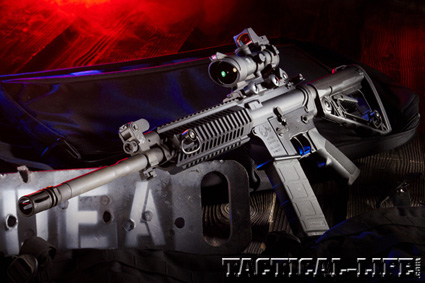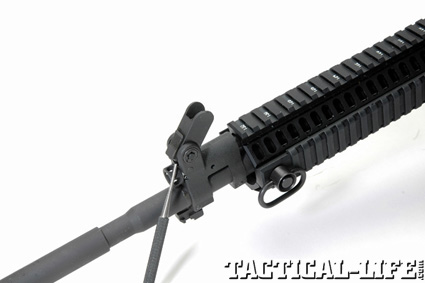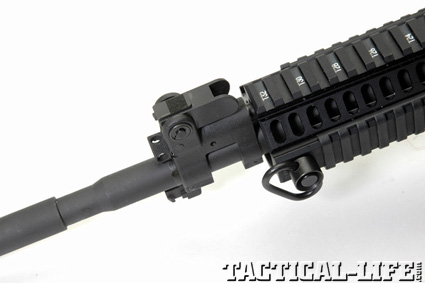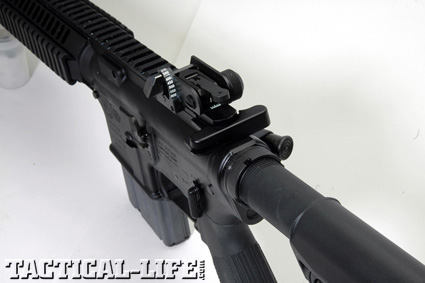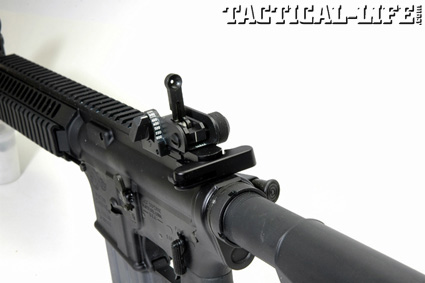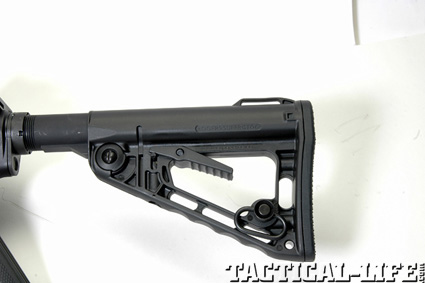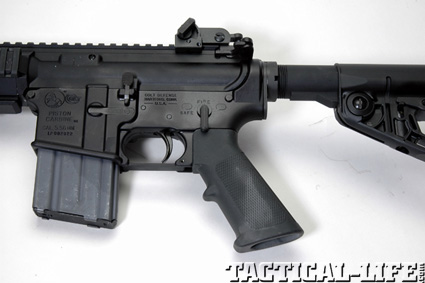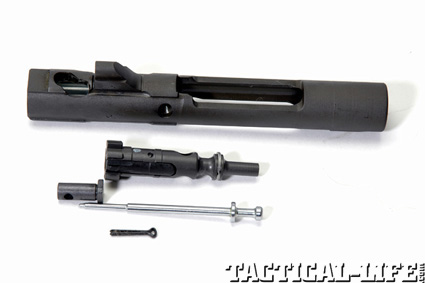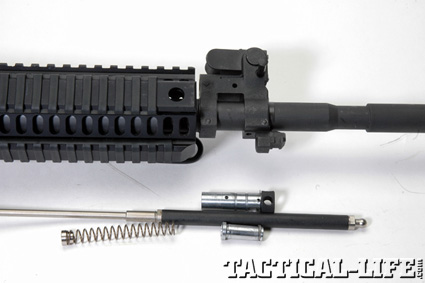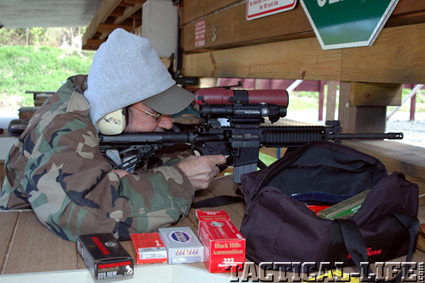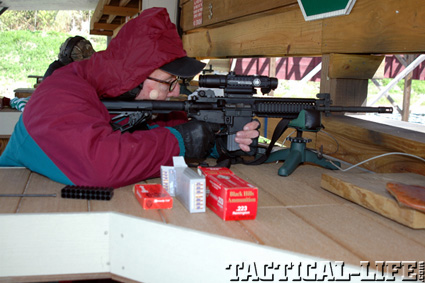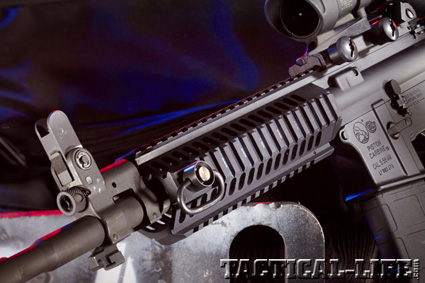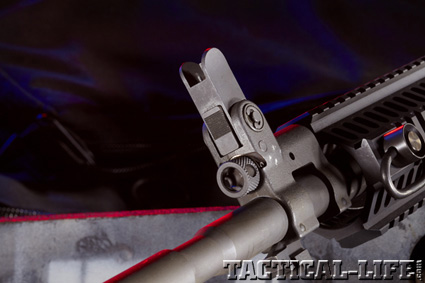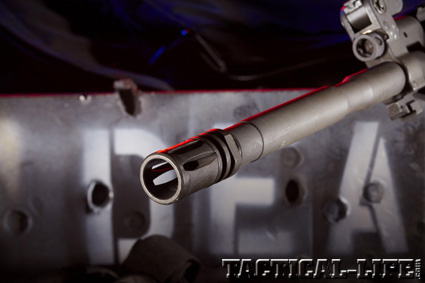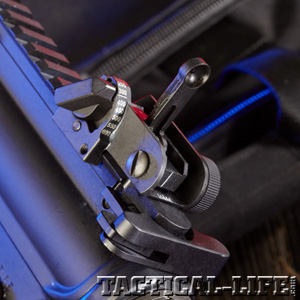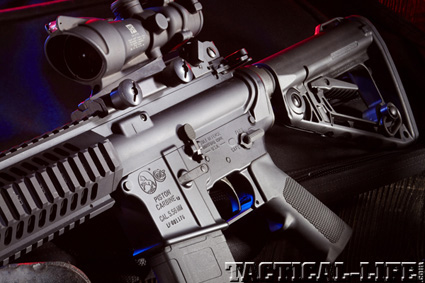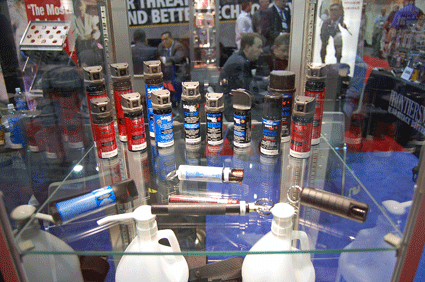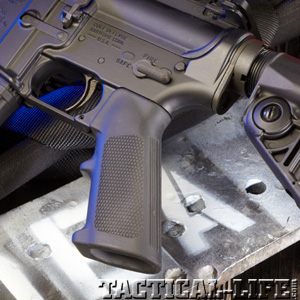The modern sporting rifle (MSR), as the semi-automatic AR-15 is now identified, is the most popular rifle in the United States. It’s used by law enforcement, outdoorsmen for predator and varmint control, for hunting where permitted, in organized competitive events and, to be sure, by legally armed citizens for self-defense in a home or elsewhere. The piston-operated Colt LE6940P carbine is one such MSR that fits the bill for this particular need, and several reasons why come to mind. Because it is chambered in 5.56mm NATO, the LE6940P allows users the ability to deliver effective single or multiple hits on one or more threats more effectively, firing a cartridge with stopping power exceeding most commonly used handgun rounds. Also, this can be accomplished at distances that exceed handgun ranges. As exact parameters cannot be established for a lethal attack, the only remaining certainty is that your life hangs in the balance.
The Colt LE6940P attempts to provide the best results gleaned from all the previously mentioned applications. I also think the “P” for Piston in its model designation could represent “personalize,” as its features enhance its use defensively.
Gun Details
The Colt LE6940P, paraphrasing from the Colt instruction manual, is an Advanced Piston (AP) operated rifle. It features a monolithic upper receiver that has a Mil-Std-1913 rails at the 12, 3 and 9 o’clock positions. The fourth rail, at 6 o’clock, is removable to give access for further cleaning of the rifle if needed. The buttstock is collapsible to provide a better fit for various body sizes and the presence of bulky clothing. The rifle weighs 6.9 pounds unloaded. Its overall length is 35.5 inches with the buttstock fully extended, and 32 inches with the buttstock collapsed.
Advertisement — Continue Reading Below
Space here prohibits a lengthy evaluation of the piston operating system used by the Colt LE6940P versus the direct gas impingement system (DGIS). But with piston-driven systems, gas formed from discharging a cartridge moves a piston and a piston rod, with the latter then impinging on the bolt to cycle the action. On the other hand, the DGIS design uses the gas that is moved through a tube to operate the bolt. This system carries gases into the rifle’s action. With the piston-operated Colt Articulating Link System, however, gases are vented off through a port near the barrel muzzle, allowing the action to stay cleaner longer. While some discussion is made of the relative accuracy of DGIS over piston-operated platforms, I see both systems as being more than adequate—perhaps more accurate than most users can deliver—for most purposes and particularly so in home-based self-defense.
The LE6940P has a 16.1-inch, chrome-lined barrel with six-groove rifling in a 1-in-7-inch twist rate. The rifle also comes with three 7-inch-long, composite rail covers to surround the handguard, as handling abruptly cornered rails by less-than-work-hardened hands without gloves can be unpleasant. The covers can be cut to length as desired.
The lower receiver is outfitted with a Rogers Super-Stoc that can be adjusted to four dif-ferent length-of-pull positions. Another feature of note is the safety selector, which is reversible for left-handed shooters.
Advertisement — Continue Reading Below
The LE6940P also comes with adjustable back-up iron sights (BUIS), which are according to the instruction manual, calibrated to make effective use of M855 ball ammunition. The front sight should be adjusted for elevation only for the initial zero. To lower the front sight, a large flat and grooved, rectangular retaining latch is moved downward. To erect the sight, pull it up until it locks automatically. The folding aperture rear sight, adjustable for windage and elevation, is held up or down by a spring-driven detent. Adjustments move the sight in 0.5-inch increments at 100 yards. The sight has white hash marks for windage and numbered white hash marks for elevation changes.
Continue Reading: Colt LE6940P 5.56mm Rifle | Gun Review
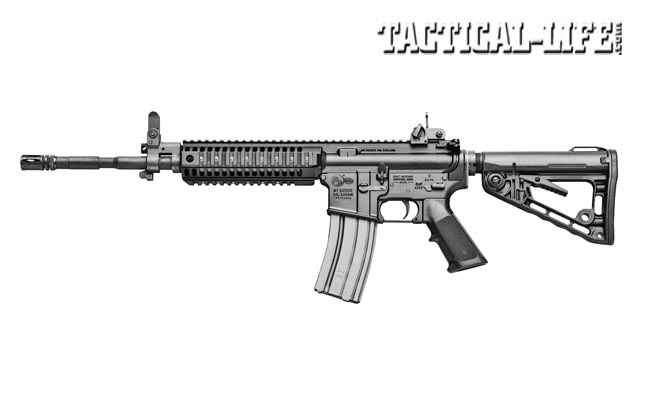
Range Time
At the range, Joe Venezia and I were able to obtain very nice five-shot groups using a 1-3x14mm Leupold Mark 4 CQ/T (Close Quarter/Tactical) sight with a 3-MOA aiming dot at 3x and a 9-MOA at 1x. We tested the LE6940P from a benchrest with high-quality ammunition from Black Hills, Hornady, CorBon and Winchester. We did not expect great results with a low-power optic and a measured, gritty 7.5-pound trigger pull, which didn’t improve despite ample lubrication and repeated dry-firing.
Advertisement — Continue Reading Below
Those things were not an impediment, however, as Joe demonstrated with his first five shots. He shoots a lot of ARs in his gunsmithing work, and it showed. After sighting in, Joe fired the Black Hills ammunition and then followed with that from CorBon. Before he looked through the spotting scope I was using, he apologized for his poor groups, pointing out that, with the scope’s magnification at 3x, the center aiming dot covers about 3 inches of the Shoot-N-C target at 100 yards. It’s good for defensive work, but not so much where the black dot is placed over a larger (7.5-inch) bullseye. Note that turning the scope’s power down increases the dot size—as it should. Again, that’s great for defensive work, not target shooting. However, I noticed both groups appeared to be smaller than 2 inches, which is inside the 3-MOA dot, as the sight was set at 3x. No apologies necessary, to be sure.
Measurements confirmed he shot well, as his first effort was a 1.5-inch five-shot group using Black Hills 73-grain Berger BTHPs, and his second was a 1.75-inch group using CorBon 69-grain BTHPs. When I got behind the rifle, I could not match his work. I managed a 1.75-inch four-shot group, with one jerked shot for a final five-shot spread of 2 inches using Winchester 55-grain Ballistic Silvertips. I followed this with another 2-inch group using Hornady 75-grain TAP Precision BTHP ammunition.
At this point, we agreed we were not going to get better results than what we had, so we stopped our formal accuracy efforts. Later, changing to assorted brands of 55-grain FMJ loads from Remington, Winchester, PMC and Federal, and with the backup sights, I was able to shoot “minute of range” debris—sticks and dirt clods—with a fair number of hits to go along with more misses. Hits, of course, resulted in flying sticks and clouds of dirt, but so too, did the near misses.
Advertisement — Continue Reading Below
There were no problems with feeding from either of the two supplied Colt-brand 20-round magazines. Extracting and ejecting were also trouble-free, with empty cases landing 6 feet to the shooter’s right rear side.
Continue Reading: Colt LE6940P 5.56mm Rifle | Gun Review
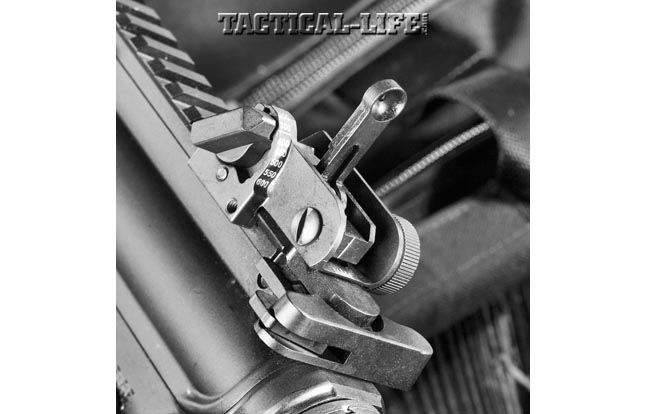
All this shooting confirmed that the piston system provides more felt recoil than the DGIS design but, while noticeable, it was not in the least bothersome physically when firing multiple shots. The lack of the DGIS system’s recoil buffer spring “twanging” in your ear was also nice. I particularly liked having the quickly detachable sling swivels and swivel holes at 9 and 12 o’clock. With the sling at 12 o’clock, the rifle is very comfortable moving around or for long-term carry. With the sling swivels at 9 o’clock, I could use a hasty sling, which, if you have the time, is a definite aid for more accurate off-hand shooting.
Advertisement — Continue Reading Below
As to our results and what should be expected from this rifle, using a tactical optic and a gritty, heavy trigger is not the best option. But these results are what can be expected if you are looking at self-defense, not self-gratification from trophy winning or bragging rights. Based on past experiences, if we used the same ammo, a 6-24x target scope and a more-polished trigger, I’m sure we’d have gotten into sub-1-inch-group territory at 100 yards!
As far as adding anything to the LE6940P for home defense, I want a quality tactical light or light and laser rather than choosing an optic, for if I can’t find and identify the problem, I can’t deal with it. So, I asked Streamlight for one of its newest tactical lights, explaining how I wanted to use it. Their rep provided the Streamlight TLR-1 HL, TLR-2 and TLR-1 HP lights. The TLR-1 HL has momentary or fixed-on white light and strobe. (the strobe can be disabled). If you do not order the HL model (the high lumen model with 630 lumens), look for the “s” after the “TLR-1” or the TLR-2 to designate the strobe model. The TLR-2 adds a laser. (It also has the strobe if you order the TLR-2s model). The TLR-1 HP is a miniature aircraft landing light, with a remote on and off switch. At a nearby open park, this one illuminates the farthest (429 meters) with a narrower cone of light compared to the others. For my use, it is too much of a good thing inside my home, but if my home were on a park-sized property, this would be the one to have. The laser option with the TLR-2 might be a better choice if the possible problem has already been identified.
As far as any discussion of which firearms to use for home defense, I’ve used and continue to use this type of rifle, along with a shotgun and a handgun (or two), as is my right. Using one over another is totally situation-dependent. For instance, it was recently reported in my local newspaper that an AR-15 rifle was used successfully by a city apartment dweller for self-defense. Paraphrasing the article, a man appearing to be on drugs wandered up to a couple standing outside their apartment unit. He stared at them for a few minutes, causing the couple to attempt to retreat to the safety of their dwelling, but the man jumped between them and pushed his way inside. The male of the couple armed himself with an AR-15 and yelled “Stop!” three times, but the threat chose to disregard this and moved toward him. He then fired one shot at the threat’s torso and called 9-1-1. The threat was pronounced dead at a nearby hospital. No charges were filed.
Advertisement — Continue Reading Below
This just goes to show that no one can or should decide what is “the best solution” for self-defense. There just isn’t such a thing! But the Colt LE6940P is definitely worth a close look.
GET THIS ISSUE NOW! at www.tactical-life.com/subscribe/gun-annual/.
